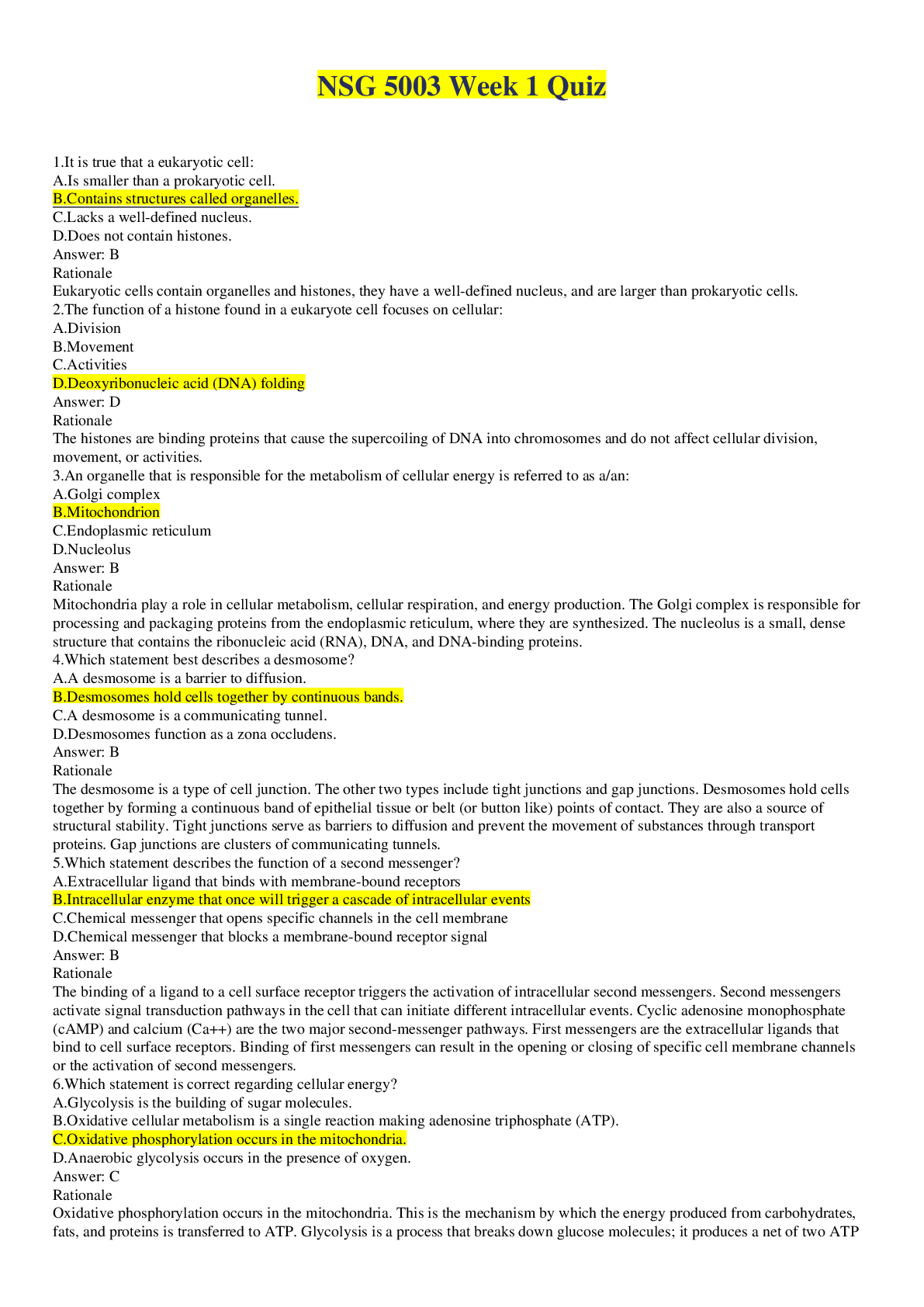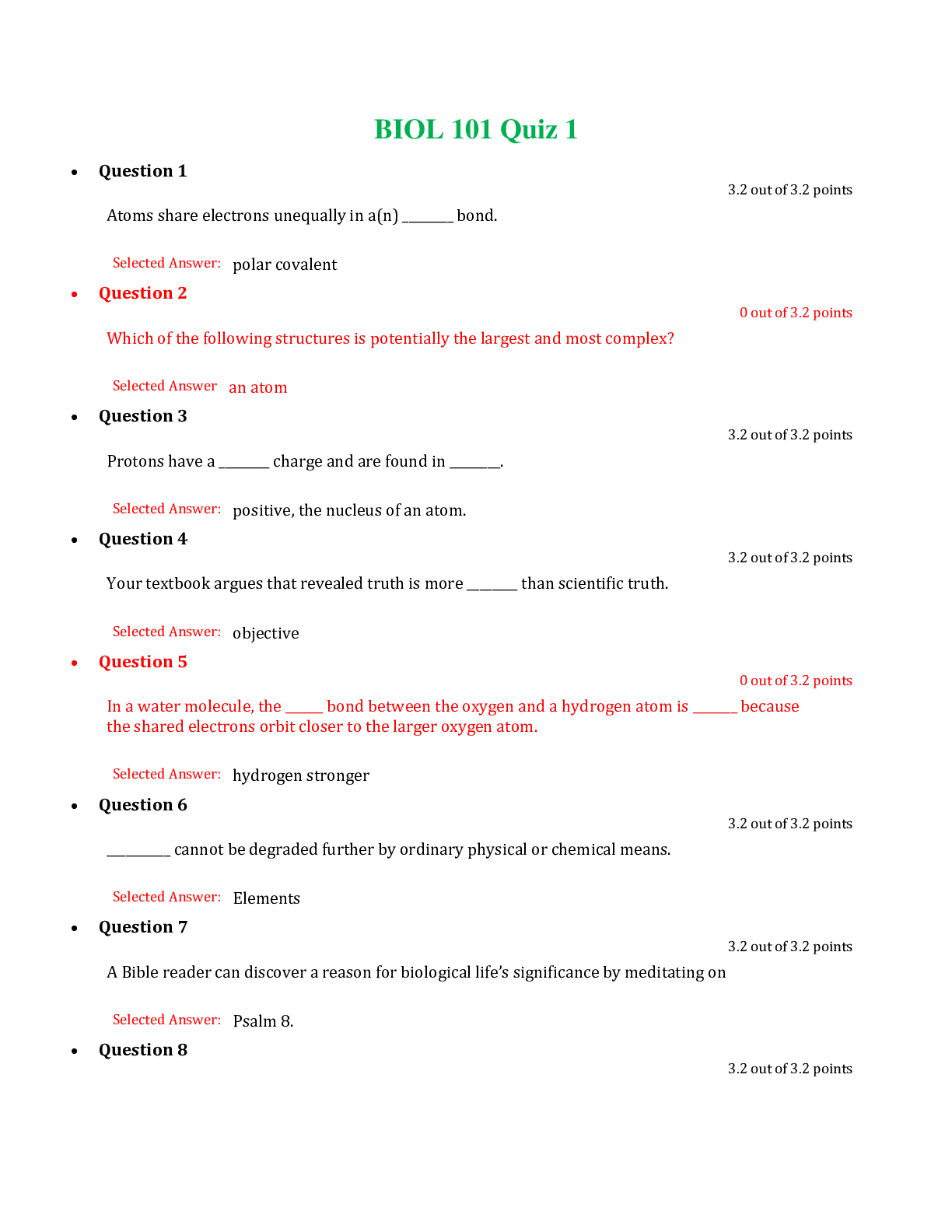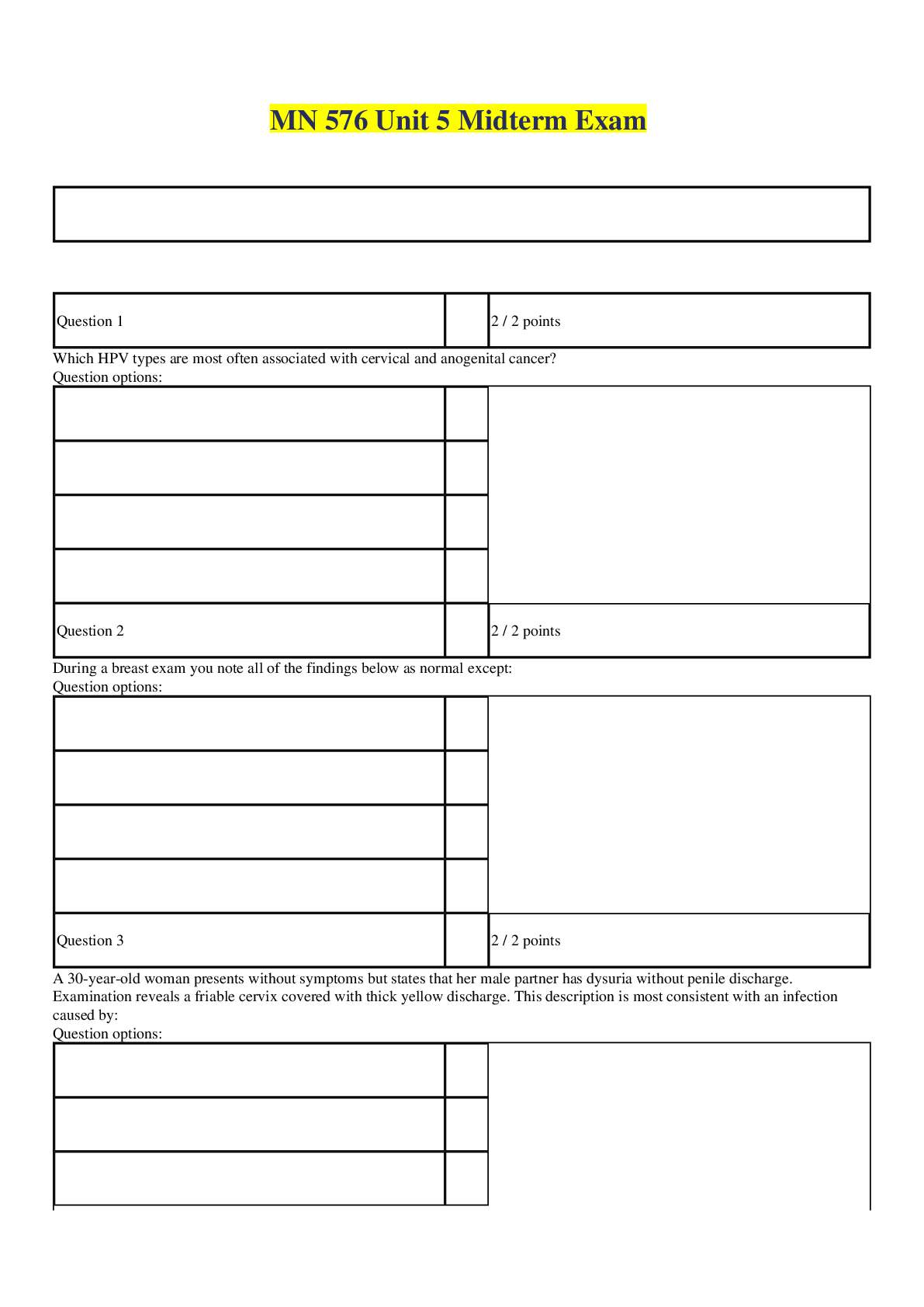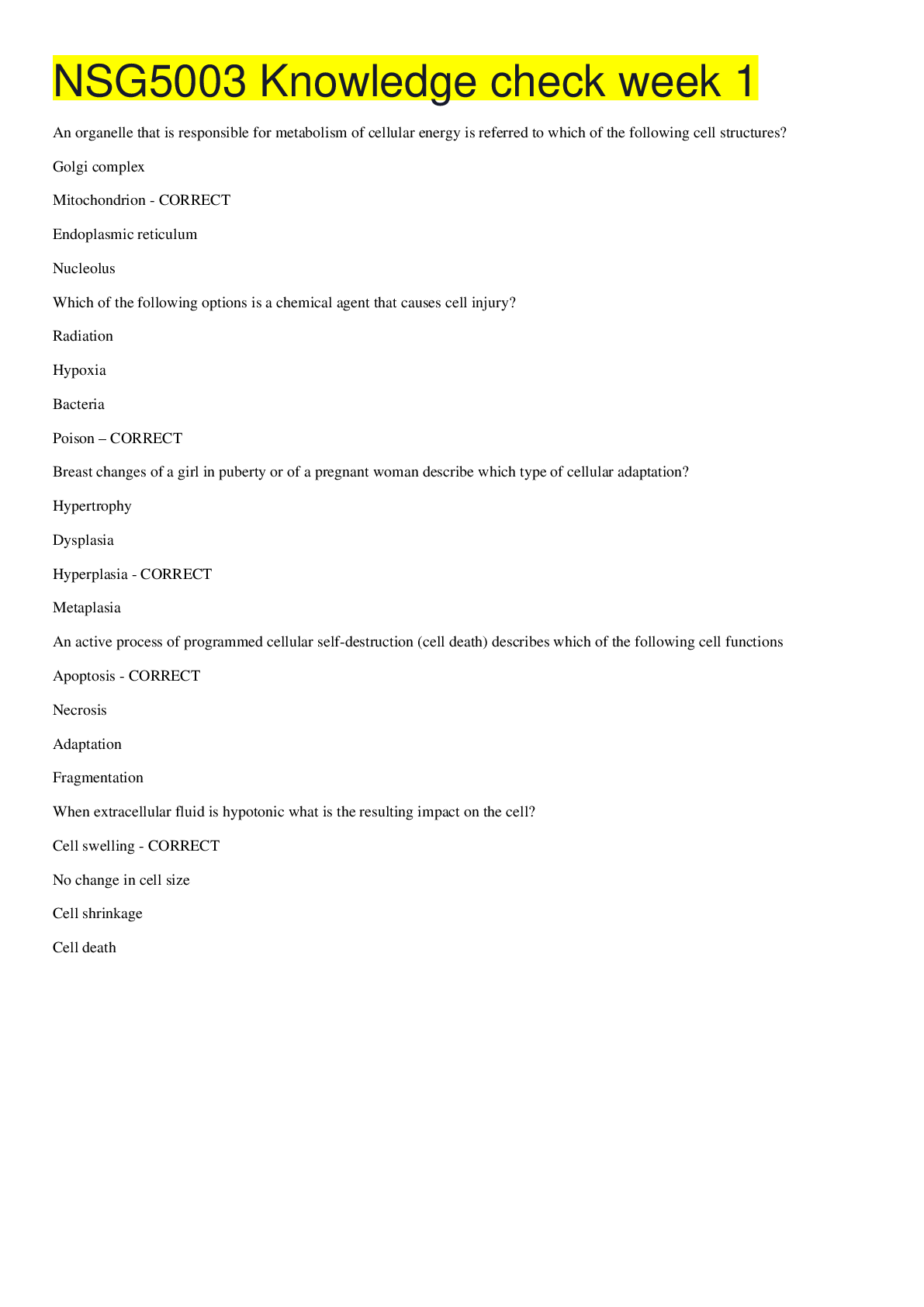*NURSING > EXAM > NSG5003 Week 1 Quiz / NSG 5003 Week 1 Quiz (Latest, 2020): South University ( Verified Answers, Down (All)
NSG5003 Week 1 Quiz / NSG 5003 Week 1 Quiz (Latest, 2020): South University ( Verified Answers, Download to Score A)
Document Content and Description Below
NSG 5003 Week 1 QUIZ / NSG5003 Week 1 QUIZ: South University South University NSG 5003 Week 1 QUIZ / South University NSG5003 Week 1 QUIZ 1. It is true that a eukaryotic cell: A. Is smaller than a pro... karyotic cell. B. Contains structures called organelles. C. Lacks a well-defined nucleus. D. Does not contain histones. 2. The function of a histone found in a eukaryote cell focuses on cellular: A. Division B. Movement C. Activities D. Deoxyribonucleic acid (DNA) folding 3. An organelle that is responsible for the metabolism of cellular energy is referred to as a/an: A. Golgi complex B. Mitochondrion C. Endoplasmic reticulum D. Nucleolus 4. Which statement best describes a desmosome? A. A desmosome is a barrier to diffusion. B. Desmosomes hold cells together by continuous bands. C. A desmosome is a communicating tunnel. D. Desmosomes function as a zona occludens. 5. Which statement describes the function of a second messenger? A. Extracellular ligand that binds with membrane-bound receptors B. Intracellular enzyme that once will trigger a cascade of intracellular events C. Chemical messenger that opens specific channels in the cell membrane D. Chemical messenger that blocks a membrane-bound receptor signal Which statement is correct regarding cellular energy? A. Glycolysis is the building of sugar molecules. B. Oxidative cellular metabolism is a single reaction making adenosine triphosphate (ATP). C. Oxidative phosphorylation occurs in the mitochondria. D. Anaerobic glycolysis occurs in the presence of oxygen. 7. Movement of a solute molecule from an area of high concentration to an area of low concentration is called: A. Diffusion B. Filtration C. Osmosis D. Hydrostatic pressure 8. Which of the following is an example of an energy-releasing process? A. Anabolism B. Catabolism C. Substrate-induced reaction D. Second messenger system Which of the following describes the term chemotaxis? A. Uses the second messenger system B. Cellular signal affecting the cell of origin C. Movement of cells along a chemical gradient D. Ligands bind with receptors, triggering a second reaction 10. Which of the following describes an amphipathic molecule? A. Hydrophobic and not Hydrophilic B. Hydrophilic and not Hydrophobic C. Hydrophobic and Hydrophilic D. Nonpolar 11. Which of the following are functions of a protein? (Select all that apply.) A. Pores or transport channels B. Enzymes that drive pumps C. Cell surface markers D. Synapses for cells 12. Which of the following is the most common cause of cellular injury? A. Free radical–induced injury B. Chemical injury C. Hypoxia D. Mechanical factors 13. Which chemical interferes with the excretion of urate while affecting the nervous and hematopoietic systems? A. Carbon monoxide B. Carbon tetrachloride C. Lead D. Mercury 14. A collection of blood that is located between the skull and the dura is called a/an: A. Epidural hematoma B. Contusion C. Subdural hematoma D. Subarachnoid hemorrhage 15. The possible diagnosis of shaken baby syndrome is supported when an infant brought to the emergency department is found to have which type of cerebral hematoma? A. Epidural B. Subdural C. Subarachnoid D. Avulsion 16. Which term describes a tear or rip of the skin with a jagged and irregular edge? A. Abrasion B. Incision C. Laceration D. Incised wound 17. Which term describes oxygen failing to reach the blood? A. Suffocation B. Strangulation C. Drowning D. Petechiae 18. Heat exhaustion is defined as: A. Chilling or freezing of the cells B. Cramping of voluntary muscles C. Hemoconcentration from salt and water loss D. Significantly decreased blood volume 19. Which statement regarding altitude and illness is true? A. Caisson disease occurs when descending too quickly while diving. B. Pulmonary edema as the result of hypoxia and increased pulmonary hypertension. C. Gas emboli are caused by oxygen bubbles. D. Altitude sickness occurs from blast injuries. 20. Which form of necrosis is associated with tuberculous infections? A. Coagulative B. Liquefactive C. Fat D. Caseous 21. Which statements are true regarding apoptosis? (Select all that apply.) A. An active process of cellular self-destruction B. A process that deletes cells during embryonic development C. Local cell death after severe and sudden injury D. Nuclear and cytoplasmic shrinkage of a cell 22. When considering water balance, which statement is the correct balance? A. Isotonic fluids cause increased cellular swelling. B. Hypertonic fluid causes increased cellular swelling. C. Hypotonic fluid causes cellular swelling. D. Hypernatremia causes cellular swelling. 23. It is true that hyperchloremia: A. Occurs with a deficit of sodium. B. Occurs with an excess of bicarbonate. C. Has specific symptoms such as thirst. D. Requires treatment of the underlying disorder. 24. It is true that hyponatremia: A. Is commonly caused by inadequate sodium intake. B. Can occur with a decrease in total body water (TBW). C. Never occurs with burns, vomiting, or diarrhea. D. Occurs when sodium drops below 135 mEq/L. 25. Which statement is true regarding potassium balance? A. Potassium is the major extracellular electrolyte. B. During acidosis, potassium shifts into the cell. C. Aldosterone is secreted when potassium is decreased. D. Insulin causes the movement of potassium into the cell. 26. Which statement is true regarding hypokalemia? A. Hypokalemia occurs when the serum level is below 135 mEq/L. B. One cause of hypokalemia is diabetic ketoacidosis. C. Dietary causes of hypokalemia are common. D. Diuretics do not cause hypokalemia. 7. Hypernatremia is defined as levels above: A. 147 mEq/L B. 5.5 mEq/L C. 105 mEq/L D. 8.5 mg/dl 28. Which statement is true regarding magnesium? A. Hypomagnesemia occurs with a concentration less than 2.5 mEq/L. B. Magnesium is a major extracellular cation. C. Thirty percent is stored in the muscle and bone. D. Symptoms of hypomagnesemia include weakness and depression. 29. Which statement describes acidemia? A. State in which the pH of arterial blood is greater than 7.45 B. State in which the pH of arterial blood is less than 7.35 C. Systemic decrease in hydrogen ion concentration D. Systemic excess of base 30. Common causes of edema formation (increased filtration of fluid from capillaries and lymph into surrounding tissues) include which of the following? (Select all that apply.) A. Decreased hydrostatic pressure B. Decreased plasma oncotic pressure C. Increased capillary membrane permeability D. Lymphatic obstruction E. Sodium retention 31. Which of the following are clinical manifestations of hypokalemia? (Select all that apply.) A. Carbohydrate metabolism is affected as a result of decreased insulin secretion. B. Renal function is impaired. C. Neuromuscular excitability is decreased. D. Skeletal muscle is affected with increased contractility. 32. Which treatments are appropriate for hyperkalemia? (Select all that apply.) A. Calcium gluconate B. Treating the contributing cause C. Administering glucagon D. Sodium bicarbonate [Show More]
Last updated: 2 years ago
Preview 1 out of 12 pages

Buy this document to get the full access instantly
Instant Download Access after purchase
Buy NowInstant download
We Accept:

Reviews( 0 )
$7.00
Can't find what you want? Try our AI powered Search
Document information
Connected school, study & course
About the document
Uploaded On
May 04, 2020
Number of pages
12
Written in
Additional information
This document has been written for:
Uploaded
May 04, 2020
Downloads
0
Views
119


























